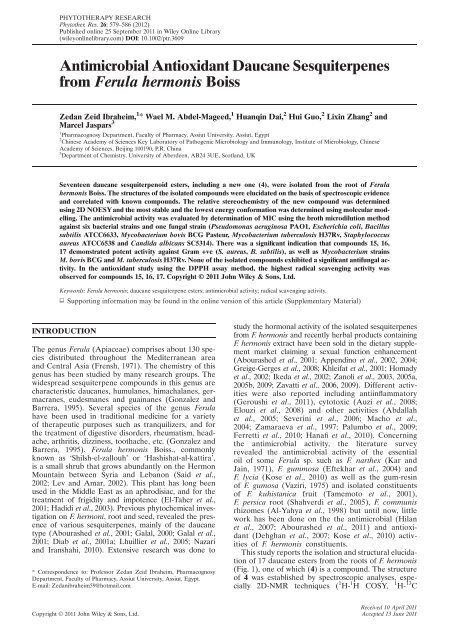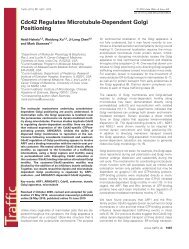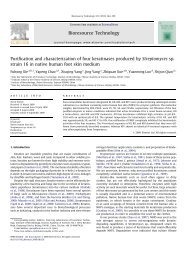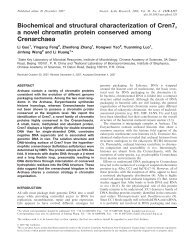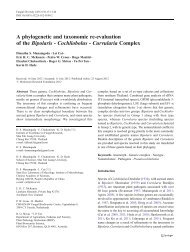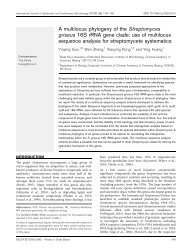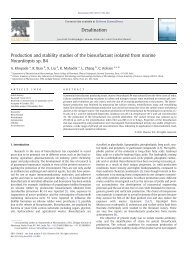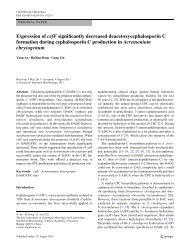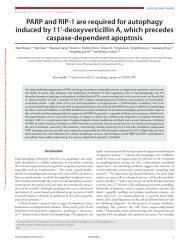Antimicrobial Antioxidant Daucane Sesquiterpenes from Ferula ...
Antimicrobial Antioxidant Daucane Sesquiterpenes from Ferula ...
Antimicrobial Antioxidant Daucane Sesquiterpenes from Ferula ...
You also want an ePaper? Increase the reach of your titles
YUMPU automatically turns print PDFs into web optimized ePapers that Google loves.
PHYTOTHERAPY RESEARCH<br />
Phytother. Res. 26: 579–586 (2012)<br />
Published online 25 September 2011 in Wiley Online Library<br />
(wileyonlinelibrary.com) DOI: 10.1002/ptr.3609<br />
<strong>Antimicrobial</strong> <strong>Antioxidant</strong> <strong>Daucane</strong> <strong>Sesquiterpenes</strong><br />
<strong>from</strong> <strong>Ferula</strong> hermonis Boiss<br />
Zedan Zeid Ibraheim, 1 * Wael M. Abdel-Mageed, 1 Huanqin Dai, 2 Hui Guo, 2 Lixin Zhang 2 and<br />
Marcel Jaspars 3<br />
1 Pharmacognosy Department, Faculty of Pharmacy, Assiut University, Assiut, Egypt<br />
2 Chinese Academy of Sciences Key Laboratory of Pathogenic Microbiology and Immunology, Institute of Microbiology, Chinese<br />
Academy of Sciences, Beijing 100190, P.R. China<br />
3 Department of Chemistry, University of Aberdeen, AB24 3UE, Scotland, UK<br />
Seventeen daucane sesquiterpenoid esters, including a new one (4), were isolated <strong>from</strong> the root of <strong>Ferula</strong><br />
hermonis Boiss. The structures of the isolated compounds were elucidated on the basis of spectroscopic evidence<br />
and correlated with known compounds. The relative stereochemistry of the new compound was determined<br />
using 2D NOESYand the most stable and the lowest energy conformation was determined using molecular modelling.<br />
The antimicrobial activity was evaluated by determination of MIC using the broth microdilution method<br />
against six bacterial strains and one fungal strain (Pseudomonas aeruginosa PAO1, Escherichia coli, Bacillus<br />
subtilis ATCC6633, Mycobacterium bovis BCG Pasteur, Mycobacterium tuberculosis H37Rv, Staphylococcus<br />
aureus ATCC6538 and Candida albicans SC5314). There was a significant indication that compounds 15, 16,<br />
17 demonstrated potent activity against Gram +ve (S. aureus, B. subtilis), as well as Mycobacterium strains<br />
M. bovis BCG and M. tuberculosis H37Rv. None of the isolated compounds exhibited a significant antifungal activity.<br />
In the antioxidant study using the DPPH assay method, the highest radical scavenging activity was<br />
observed for compounds 15, 16, 17. Copyright © 2011 John Wiley & Sons, Ltd.<br />
Keywords: <strong>Ferula</strong> hermonis; daucane sesquiterpene esters; antimicrobial activity; radical scavenging activity.<br />
Supporting information may be found in the online version of this article (Supplementary Material)<br />
INTRODUCTION<br />
The genus <strong>Ferula</strong> (Apiaceae) comprises about 130 species<br />
distributed throughout the Mediterranean area<br />
and Central Asia (Frensh, 1971). The chemistry of this<br />
genus has been studied by many research groups. The<br />
widespread sesquiterpene compounds in this genus are<br />
characteristic daucanes, humulanes, himachalanes, germacranes,<br />
eudesmanes and guainanes (Gonzalez and<br />
Barrera, 1995). Several species of the genus <strong>Ferula</strong><br />
have been used in traditional medicine for a variety<br />
of therapeutic purposes such as tranquilizers, and for<br />
the treatment of digestive disorders, rheumatism, headache,<br />
arthritis, dizziness, toothache, etc. (Gonzalez and<br />
Barrera, 1995). <strong>Ferula</strong> hermonis Boiss., commonly<br />
known as ‘Shilsh-el-zallouh’ or ‘Hashishat-al-kattira’,<br />
is a small shrub that grows abundantly on the Hermon<br />
Mountain between Syria and Lebanon (Said et al.,<br />
2002; Lev and Amar, 2002). This plant has long been<br />
used in the Middle East as an aphrodisiac, and for the<br />
treatment of frigidity and impotence (El-Taher et al.,<br />
2001; Hadidi et al., 2003). Previous phytochemical investigation<br />
on F. hermoni, root and seed, revealed the presence<br />
of various sesquiterpenes, mainly of the daucane<br />
type (Abourashed et al., 2001; Galal, 2000; Galal et al.,<br />
2001; Diab et al., 2001a; Lhuillier et al., 2005; Nazari<br />
and Iranshahi, 2010). Extensive research was done to<br />
* Correspondence to: Professor Zedan Zeid Ibraheim, Pharmacognosy<br />
Department, Faculty of Pharmacy, Assiut University, Assiut, Egypt.<br />
E-mail: Zedanibraheim59@hotmail.com<br />
study the hormonal activity of the isolated sesquiterpenes<br />
<strong>from</strong> F. hermonis and recently herbal products containing<br />
F. hermonis extract have been sold in the dietary supplement<br />
market claiming a sexual function enhancement<br />
(Abourashed et al., 2001; Appendino et al., 2002, 2004;<br />
Greige-Gerges et al., 2008; Khleifat et al., 2001; Homady<br />
et al., 2002; Ikeda et al., 2002; Zanoli et al., 2003, 2005a,<br />
2005b, 2009; Zavatti et al., 2006, 2009). Different activities<br />
were also reported including antiinflammatory<br />
(Geroushi et al., 2011), cytotoxic (Auzi et al., 2008;<br />
Elouzi et al., 2008) and other activities (Abdallah<br />
et al., 2005; Severini et al., 2006; Macho et al.,<br />
2004; Zamaraeva et al., 1997; Palumbo et al., 2009;<br />
Ferretti et al., 2010; Hanafi et al., 2010). Concerning<br />
the antimicrobial activity, the literature survey<br />
revealed the antimicrobial activity of the essential<br />
oil of some <strong>Ferula</strong> sp. such as F. narthex (Kar and<br />
Jain, 1971), F. gummosa (Eftekhar et al., 2004) and<br />
F. lycia (Kose et al., 2010) as well as the gum-resin<br />
of F. gumosa (Vaziri, 1975) and isolated constituents<br />
of F. kuhistanica fruit (Tamemoto et al., 2001),<br />
F. persica root (Shahverdi et al., 2005), F. communis<br />
rhizomes (Al-Yahya et al., 1998) but until now, little<br />
work has been done on the the antimicrobial (Hilan<br />
et al., 2007; Abourashed et al., 2011) and antioxidant<br />
(Dehghan et al., 2007; Kose et al., 2010) activities<br />
of F. hermonis constituents.<br />
This study reports the isolation and structural elucidation<br />
of 17 daucane esters <strong>from</strong> the roots of F. hermonis<br />
(Fig. 1), one of which (4) is a compound. The structure<br />
of 4 was established by spectroscopic analyses, especially<br />
2D-NMR techniques ( 1 H- 1 H COSY,<br />
1 H- 13 C<br />
Copyright © 2011 John Wiley & Sons, Ltd.<br />
Received 10 April 2011<br />
Accepted 13 June 2011
580 Z. Z. IBRAHEIM ET AL.<br />
15<br />
10 9<br />
2<br />
1<br />
8<br />
3<br />
5<br />
4<br />
7<br />
6<br />
HO<br />
H<br />
11 OR<br />
13<br />
12<br />
OH<br />
14<br />
15<br />
10 9<br />
2 1<br />
8<br />
3<br />
5<br />
4<br />
7<br />
6<br />
HO<br />
H<br />
11 OR<br />
13<br />
12<br />
14<br />
OH<br />
HO<br />
H<br />
OR 2<br />
R 1<br />
R 1 R 2<br />
1 R = Bz 4 R = Bz 5 O Bz<br />
2 R = p-HyBz 6 O p-HyBz<br />
3 R = Van 7 O Van<br />
8 α-OH, H Bz<br />
9 α-OH, H p-HyBz<br />
10 α-OH, H Van<br />
O<br />
RO<br />
O<br />
HO<br />
H<br />
OR<br />
OH<br />
HO<br />
H<br />
OR<br />
11 R = Bz 14 R = Angelyl 15 R = Bz<br />
12 R = p-HyBz 16 R = p-HyBz<br />
13 R = Van 17 R = Van<br />
O<br />
O<br />
O<br />
Bz = p-HyBz = Van =<br />
OH<br />
OH<br />
OCH<br />
Figure 1. Chemical structures of compounds 1–17.<br />
HSQC, 1 H- 13 HMBC, NOESY) as well as using accurate<br />
mass measurement. The most stable and the lowest<br />
energy conformation was determined using molecular<br />
modelling. The isolated compounds were tested on a<br />
panel of pathogenic microbial strains for antimicrobial<br />
activities, following the Clinical and Laboratory Standards<br />
Institute (CLSI, formerly NCCLS) broth microdilution<br />
method in 96-well microplates. The radical<br />
scavenging-activity of the isolated compounds was also<br />
evaluated using the DPPH assay method.<br />
MATERIALS AND METHODS<br />
General experimental procedures. The IR spectra were<br />
measured on an Ati Mattson Genesis Series FTIR machine.<br />
The 1D and 2D-NMR experiments were<br />
recorded on Varian Unity INOVA 400 MHz NMR systems.<br />
Low resolution ESI-MS data were obtained using<br />
a Perseptive Biosystems Mariner LC-MS, and highresolution<br />
ESI-MS data were obtained on a Finnigan<br />
MAT 900 XLT system. The HPLC separations were carried<br />
out using a Phenomenex reversed-phase column<br />
(Jupiter 4 mm Proteo 90 Å, 250 10 mm, 4 mm) and an<br />
Agilent 1200 series gradient pump monitored using a<br />
DAD G1315B variable-wavelength UV detector.<br />
Column chromatography (CC) was performed using a<br />
silica gel (Kieselgel 60 Å, 40–63 mM mesh size, Fluorochem,<br />
UK), size exclusion chromatography (Sephadex<br />
LH-20, 25–100 mm mesh size, Sigma, Germany) and<br />
using TLC pre-coated silica-gel 60 F254 (0.25 mm, Alugram<br />
W SIL G/UV 254 , Macherey-Nagel, Germany) and<br />
RP-18 F254S plates (0.25 mm, Merck, Germany). All<br />
flash chromatography was performed on Biotage cartridge<br />
flash columns (Si 40 M and C18 HS 40 M) using a<br />
Biotage Flash system, Charlottesville, USA.<br />
Plant materials. The roots of <strong>Ferula</strong> hermonis Boiss.<br />
(2.1 kg) were obtained <strong>from</strong> Damascus, Syria in July<br />
2008. The plant was kindly authenticated by Professor<br />
G. El-Naggar, Professor of Taxonomy, Faculty of Science,<br />
Assiut University, Assiut, Egypt. A voucher specimen<br />
(No 2008FH) was deposited at the Pharmacognosy<br />
Department, Assiut University, Assiut, Egypt.<br />
Extraction and isolation. The air-dried powdered root<br />
of <strong>Ferula</strong> hermonis (500 g) was extracted exhaustively<br />
in a soxhlet apparatus with ethyl alcohol. The ethanol<br />
extract was concentrated in vacuo to give a residue,<br />
which was partitioned between chloroform and water.<br />
The chloroform layer was evaporated under reduced<br />
pressure to dryness to give an oily yellow mass (55 g,<br />
11%). Part (20 g) of the chloroform fraction was<br />
Copyright © 2011 John Wiley & Sons, Ltd. Phytother. Res. 26: 579–586 (2012)
DAUCANE SESQUITERPENES FROM FERULA HERMONIS<br />
581<br />
chromatographed on a silica gel column (700 g) and<br />
eluted with a gradient mixture of n-hexane–EtOAc.<br />
Fractions (200 mL each) were collected and monitored<br />
on TLC using benzene–EtOAc mixtures as solvent systems<br />
and H 2 SO 4 (10% in MeOH) as a spraying reagent.<br />
Similar fractions were mixed and concentrated to yield<br />
four groups.<br />
Group 1 (fractions 1–10, n-hexane–EtOAc, 9:1) was<br />
further re-chromatographed on a silica gel column using<br />
5% to 15% EtOAc in n-hexane gradiently as the eluent.<br />
Four compounds were obtained: compound 15 (200 mg,<br />
yellow oil), compound 5 (70 mg, colourless oil), compound<br />
14 (45 mg, colourless oil) and 11 (47 mg, amorphous<br />
powder).<br />
Group 2 (fractions 11–25, n-hexane–EtOAc, 4:1) was<br />
further re-chromatographed on silica gel column using<br />
gradient elution of 10% to 30% EtOAc in n-hexane followed<br />
by 5% to 15% MeOH in CHCl 3 as eluent to give<br />
three sub-fractions. The sub-fractions were subjected to<br />
gel filtration chromatography using a Sephadex LH-20<br />
column with CHCl 3 –MeOH (3:2) followed by HPLC<br />
(silica gel, Hex–EtOAc, 3:2) to give compounds 16<br />
(660 mg, yellow oil), 17 (90 mg, amorphous powder), 6<br />
(63 mg, colourless needles), 7 (12 mg, amorphous powder),<br />
8 (23 mg, oily substances) and 4 (19 mg, amorphous<br />
powder).<br />
Group 3 (fractions 26–30, n-hexane–EtOAc, 7:3) was<br />
subjected to gel filtration chromatography using a<br />
Sephadex LH-20 column with CHCl 3 –MeOH (3:2) followed<br />
by reversed-phase HPLC (Jupiter 4 mm Proteo<br />
90 Å, 250 10 mm, 4 mm) using a gradient of 0–100%<br />
CH 3 CN–H 2 O over 40 min to give compound 1 (35 mg,<br />
colourless oil), 9 (14 mg, amorphous substance) and 10<br />
(5 mg, amorphous substance).<br />
Group 4 (fractions 31–40, n-hexane–EtOAc, 3:2) was<br />
subjected to gel filtration chromatography using a<br />
Sephadex LH-20 column with CHCl 3 –MeOH (3:2) followed<br />
by reversed-phase HPLC (Jupiter 4 mm Proteo<br />
90 A o , 250 10 mm, 4 mm) using a gradient of 0–100%<br />
CH 3 CN–H 2 O over 40 min to give compound 12<br />
(29 mg, amorphous substance), 13 (6.2 mg, amorphous<br />
substance), 2 (13 mg, amorphous substance) and 3<br />
(7.3 mg, amorphous substance).<br />
Compound 4. Amorphous powder (19 mg). [a] 25<br />
D -27 (c<br />
0.2, MeOH); IR (KBr) v max 3463, 3190, 2982, 1685,<br />
1610, 1520, 1455, 1366, 1255, 1117, 1085 cm -1 ; ESIMS<br />
m/z 381.2 [M + Na] + ; HRESIMS m/z 381.20407<br />
([M + Na] + , calcd for C 22 H 30 NaO 4 , 381.20418, Δ = 0.29<br />
ppm); 1 H (400 MHz, CDCl 3 ) and 13 C (100 MHz, CDCl 3 )<br />
NMR data in Table 1.<br />
Compound 1. Colourless oil (35 mg). [a] 25<br />
D +4.7 (c 0.5,<br />
MeOH); IR (KBr) v max 3520, 3194, 2977, 1681, 1614,<br />
1523, 1452, 1369, 1247, 1110, 1077 cm -1 ; ESIMS m/z<br />
381.2 [M + Na] + ; HRESIMS m/z 381.20416 ([M + Na] + ,<br />
calcd for C 22 H 30 NaO 4 , 381.20418, Δ = 0.05 ppm), 1 H<br />
(400 MHz, CDCl 3 ) and 13 C (100 MHz, CDCl 3 ) NMR<br />
data in Table 1.<br />
Evaluation of antimicrobial activity. The fungal strain<br />
used in the antifungal activity assay was Candida albicans<br />
SC5314 as a representative fungus for candidiasis.<br />
Bacterial strains used were Pseudomonas aeruginosa<br />
PAO1 (PA), Escherichia coli (EC), Bacillus subtilis<br />
ATCC6633 (BS), Staphylococcus aureus ATCC6538<br />
(SA), Mycobacterium bovis BCG Pasteur 1173P2 and<br />
Mycobacterium tuberculosis H37Rv (MTB). Strains were<br />
preserved in glycerol stocks at 80 C, and sub-cultured<br />
at 37 Cbeforeuse.<br />
Chemicals for antimicrobial assay. Vancomycin hydrochloride<br />
(Van), tetracycline hydrochloride (Tet), chloramphenicol<br />
(Chl), ciprofloxacin (Cip), ketoconazole<br />
(Kez) and isoniazid (INH) were purchased <strong>from</strong><br />
Sigma-Aldrich Co., used as positive controls in the susceptibility<br />
testing assay. Chemical agents were dissolved<br />
in DMSO with a concentration of 1 mg/mL, stored<br />
at 20 C until usage. Compounds were adjusted to<br />
the proper concentration before use.<br />
Assay for anti-SA, anti-PA, anti-B. subtilis and anti-<br />
E. coli activity. All the screening assays were performed<br />
according to the <strong>Antimicrobial</strong> Susceptibility Testing<br />
Standards outlined by the Clinical and Laboratory Standards<br />
Institute (CLSI) (2006).<br />
The SA, PA, B. subtilis and E. coli strains were recovered<br />
<strong>from</strong> glycerol stocks, respectively, by culturing on a<br />
LB agar plate overnight aerobically at 37 C, single colonies<br />
were picked and adjusted to approximately 1 10 4<br />
CFU/mL with Mueller-Hinton broth as bacterial suspensions.<br />
Aliquots (80 mL) of the bacterial suspension<br />
were added to each well of the 96-well microplates (Fbottom,<br />
Greiner Bio-One Ltd), followed by the addition<br />
of 2 mL compound solutions (1 mg/mL) in each test well,<br />
which gave 25 mg/mL as the final test concentration of<br />
each compound. Serial dilutions of control drugs were<br />
added to the left column on each plate as positive controls<br />
(positive control drugs were settled as Van for SA<br />
assay, Tet for BS assay, Cip for PA assay, and Chl for<br />
EC assay). Two mL of DMSO was added to each well<br />
of the right column (column 12), serving as a negative<br />
control. After 16 h incubation at 37 C, bacterial growth<br />
in each well was inspected by the measurement of<br />
OD 600 in a multi-label plate reader (Perkin Elmer En<br />
Vision). Active hits were defined as compounds that<br />
exhibited a growth inhibitory effect at a concentration<br />
of 25 mg/mL in the primary screening assay.<br />
For MIC determination, overnight cultures of the<br />
bacteria strains were diluted with fresh M-H broth,<br />
and standardized to 1 10 4 CFU/mL as the bacteria suspension.<br />
Two mL of 2-fold serial dilution of each compound<br />
(concentration ranging <strong>from</strong> 1 mg/mL to7.8 mg/mL)<br />
was added to each row on a 96-well plate containing<br />
78 mL of bacteria suspension in each well. Positive and<br />
negative controls were included in each plate as<br />
described in the primary screening assay. Plates were<br />
incubated at 37 C for 16 h and checked for bacteria<br />
growth. The MIC here is defined as the lowest concentration<br />
of compound that resulted in inhibition of visible<br />
bacterial growth (no turbidity) compared with the positive<br />
control antibiotics.<br />
Assay for anti-BCG and MTB (H37Rv) in logarithmic<br />
phase of growth. The in vitro activity of compounds<br />
against M. bovis BCG Pasteur and M. tuberculosis<br />
H37Rv was determined in a 96-well plate format as<br />
described previously (Wang et al., 2010), modified <strong>from</strong><br />
that reported by Collins et al. (1998). The BCG and<br />
MTB strains used here were transformed with green<br />
fluorescent protein (GFP) constitutive expression<br />
Copyright © 2011 John Wiley & Sons, Ltd. Phytother. Res. 26: 579–586 (2012)
582 Z. Z. IBRAHEIM ET AL.<br />
Table 1.<br />
1 H (400 MHz) and 13 C-NMR (100 MHz) data of 1 and 4 in CDCl 3<br />
1 4<br />
Position<br />
d 1 H/ppm, mult., J/Hz d 13 C/ppm, mult. d 1 H/ppm, mult., J/Hz d 13 C/ppm, mult.<br />
1 – 46.2, C – 46.1, C<br />
2 a. 1.41-1.33 (1H,m) 41.4, CH 2 a. 1.47-1.39 (1H,m) 41.4, CH 2<br />
b. 1.67-1.59 (1H,m) b. 1.67-1.59 (1H,m)<br />
3 a. 1.63-1.54 (1H,m) 31.2, CH 2 a. 1.63-1.54 (1H,m) 31.2, CH 2<br />
b. 1.97-1.89 (1H,m) b. 2.00-1.90 (1H,m)<br />
4 – 85.6, C – 85.9, C<br />
5 2.47 (1H,d, 10.8) 52.3, CH 2.90 (1H,d, 10.6) 52.7, CH<br />
6 5.83 (1H, dddd, 1.95, 5.5, 10.8, 12.8) 73.0, CH 5.86 (1H, q, 5.5) 72.5, CH<br />
7 a. 2.49 (1H, dd, 5.5, 15.5) 46.0, CH 2 a. 2.43 (1H, dd, 5.5, 16.2) 44.6, CH 2<br />
b. 2.10 (1H, dt, 1.7, 15.5) b. 2.12 (1H, m)<br />
8 – 71.1, C – 71.6, C<br />
9 5.46 (1H, dd, 2.0, 11.6) 134.8, CH 5.46 (1H, d, 11.4) 132.4, CH<br />
10 5.56 (1H, d, 11.6) 138.2, CH 5.65 (1H, d, 11.4) 141.6, CH<br />
11 1.58-1.51 (1H, m) 36.8, CH 1.64-1.56 (1H, m) 36.9, CH<br />
12 0.84 (3H, d, 6.6) 18.6, CH 3 0.88 (3H, d, 6.7) 18.7, CH 3<br />
13 0.82 (3H, d, 6.6) 17.6, CH 3 0.83 (3H, d, 6.7) 17.6, CH 3<br />
14 1.60 (3H, s) 29.2, CH 3 1.33 (3H, s) 34.2, CH 3<br />
15 1.26 (3H,s) 21.5, CH 3 1.24 (3H,s) 20.5, CH 3<br />
1′ – 130.5, C – 130.5, C<br />
2′ 8.00 (1H, d, 8.0) 129.9, CH 8.02 (1H, d, 8.0) 129.9, CH<br />
3′ 7.44 (1H, t, 8.0) 128.8, CH 7.44 (1H, t, 8.0) 128.8, CH<br />
4′ 7.57 (1H, t, 8.0) 133.5, CH 7.60 (1H, t, 8.0) 133.5, CH<br />
5′ 7.44 (1H, t, 8.0) 128.8, CH 7.44 (1H, t, 8.0) 128.8, CH<br />
6′ 8.00 (1H, d, 8.0) 129.9, CH 8.02 (1H, d, 8.0) 129.9, CH<br />
7′ – 167.1, C – 167.1, C<br />
plasmid pSC301 (Cowley and Av-Gay, 2001), thus the<br />
fluorescence could be a direct readout reflecting bacterial<br />
viability and growth (Changsen et al., 2003). Briefly,<br />
BCG and MTB H37Rv were grown at 37 C to mid log<br />
phase in Middlebrook 7H9 broth supplemented with<br />
10% OADC enrichment (Becton Dickinson) 0.05%<br />
Tween-80 and 0.2% glycerol, which was then adjusted<br />
to OD 600 nm = 0.025 with culture medium as the bacterial<br />
suspension. For primary screening, aliquots (80 mL)<br />
of the bacterial suspension were added to each well of<br />
the clear flat-bottom 96-well microplates, followed by<br />
the addition of 2 mL compound solutions (1 mg/mL).<br />
Subsequent serial dilutions of isoniazid were conducted<br />
in the left column, serving as the positive control, while<br />
the right column containing 2 mL of DMSO served as the<br />
drug free control. The plates were sealed with breathable<br />
film and incubated at 37 C for 3 days for M. bovis<br />
BCG or 10 days for M. tuberculosis. The GFP fluorescence<br />
was measured with a Perkin-Elmer Envision<br />
2103 multi-label reader using the bottom read mode,<br />
with excitation at 485 nm and emission at 535 nm. Hits<br />
were defined as compounds that could inhibit more than<br />
90% of bacterial growth compared with the drug free<br />
control group.<br />
For MIC determination of the hits compounds, bacterial<br />
suspensions were prepared and dispensed as<br />
described above, and compounds were serially diluted<br />
two-fold <strong>from</strong> 25 to 0.19 mg/mL in each column. Isoniazid<br />
as a positive control (800 ng/mL to 6.25 ng/mL) and<br />
DMSO as a blank control were also included in each<br />
plate. After incubation at 37 C for an appropriate time,<br />
the bacterial growth condition was inspected by GFP<br />
fluorescence measurement. Here, MIC is defined as the<br />
minimum concentration of drug that inhibited more than<br />
90% of bacteria growth reflected by fluorescence value.<br />
Antifungal and synergistic antifungal screening.<br />
Candida albicans SC5314 was used as a test strain for<br />
the antifungal and synergistic antifungal bioassay<br />
(Zhang et al., 2007). Experiments were carried out in<br />
96-well microplates (F-bottom, Greiner Bio-One Ltd),<br />
using a broth microdilution protocol modified <strong>from</strong> the<br />
CLSI M-27A methods. Overnight cultures were chosen<br />
to prepare the culture suspension with medium RPMI<br />
1640 at a concentration of 1 10 4 CFU/mL. Two mL of<br />
the test compounds was added to the test wells in 96<br />
well-plates followed by the addition of 80 mL of the culture<br />
suspension. The test plates were incubated at 35 C<br />
for 16 h. The antifungal positive control was ketoconazole,<br />
and antifungal minimal inhibition concentrations<br />
(MICs) were determined by measuring and comparing<br />
the optical diversities of the blank control and tested<br />
wells. For the synergistic antifungal assay, ketoconazole<br />
was supplemented into the culture suspension with a<br />
concentration of one quarter the MIC according to the<br />
antifungal result, and the remaining procedures were<br />
conducted as for the antifungal assay. All the experiments<br />
were tested in triplicate.<br />
DPPH radical-scavenging assay. Firstly, radical scavenging<br />
activity of sesquiterpenes against stable DPPH •<br />
was performed with a rapid TLC screening method<br />
using 0.2% DPPH in methanol. Then 30 min after spraying,<br />
the active compounds appeared as yellow spots<br />
against purple background (Braca et al., 2002; Yrjönen<br />
et al., 2003).<br />
Copyright © 2011 John Wiley & Sons, Ltd. Phytother. Res. 26: 579–586 (2012)
DAUCANE SESQUITERPENES FROM FERULA HERMONIS<br />
583<br />
In a second experiment, the spectrophotometric assay<br />
was carried out according to the method of Yen and<br />
Chen (1995). Briefly, 2.0 mL of a wide range of concentrations<br />
(2.5–120 mM) of test sample (in methanol) was<br />
added to 2.0 mL of 100 mM of methanol solution of<br />
DPPH. The mixture was vortexed for 1 min and then<br />
left to stand at room temperature for 30 min in the dark.<br />
When DPPH • reacts with an antioxidant compound,<br />
which can donate hydrogen, it is reduced and the<br />
changes in colour (<strong>from</strong> deep-violet to light-yellow)<br />
were measured at 517 nm on a UV/visible light spectrophotometer<br />
(Perkin-Elmer Instruments, Lambda 25<br />
(UV/VIS) spectrometer). Absorption of the blank sample<br />
containing the same amount of methanol and DPPH<br />
solution was prepared and measured daily. The experiment<br />
was carried out in triplicate, using ascorbic acid<br />
as a positive control standard. The percentage reduction<br />
of the DPPH, Q, referred to ‘inhibition or quenching’<br />
was calculated by the following formula (Shin-ya et al.,<br />
1993; Abdel-Mageed et al., 2010):<br />
A<br />
B<br />
13<br />
a<br />
b<br />
11 12<br />
3<br />
b<br />
2<br />
a<br />
4 5<br />
b<br />
15 10<br />
1<br />
6 7<br />
a<br />
b<br />
8<br />
9<br />
14<br />
Q ð% InhibitionÞ ¼ A B A A<br />
100<br />
A B<br />
where A B is the absorption of the blank sample (t =0<br />
min) and A A is the absorption of the tested extract solution<br />
(t = 30 min).<br />
2<br />
a<br />
10<br />
1<br />
9<br />
RESULTS AND DISCUSSION<br />
A combination of flash or medium-pressure liquid<br />
chromatography (MPLC), gel filtration and HPLC of<br />
the chloroform fraction obtained <strong>from</strong> the roots of<br />
F. hermonis afforded 17 daucane sesquiterpenes (1–17),<br />
one of which is a new sesquiterpene ester. The structures<br />
of all compounds were elucidated by IR, MS and extensive<br />
NMR analysis.<br />
Sixteen known daucane sesquiterpenes (1–3, 5–17)<br />
(Fig. 1) were identified as 4ß,8ß-dihydroxy-6a-benzoyldauc-9-ene<br />
(feruhermonin B) (1) (Auzi et al., 2008);<br />
4ß,8ß-dihydroxy-6a-p-hydroxybenzoyl-dauc-9-ene (2)<br />
(Garg and Agarwal, 1987); 4ß,8ß-dihydroxy-6a-<br />
(4-hydroxy-3-methoxybenzoyl)-dauc-9-ene (3) (Auzi<br />
et al., 2008); 4ß-hydroxy-6a-benzoyl-7-daucen-9-one<br />
(feruhermonin A) (5) (Auziet al., 2008); 4ß-hydroxy-6ap-hydroxybenzoyl-7-daucen-9-one<br />
(lancerdiol p-hydroxybenzoate)<br />
(6) (Fraga et al.,1985); 4ß-hydroxy-6a-(4-<br />
hydroxy-3-methoxybenzoyl)-7-daucen-9-one (lancerdiol<br />
vanillate) (7) (Miski, 1987); 4ß,9a-dihydroxy-6abenzoyl-dauc-7-ene<br />
(lancerotriol benzoate) (8) (Auzi<br />
et al., 2008); 4ß,9a-dihydroxy-6a-p-hydroxybenzoyldauc-7-ene<br />
(lancerotriol p-hydroxybenzoate) (9)<br />
(Fraga et al., 1985); 4ß,9a-dihydroxy-6a-(4-hydroxy-3-<br />
methoxybenzoyl)-dauc-7-ene (lancerotriol vanillate) (10)<br />
(Miski and Jakupovic, 1990); 2,3-epoxy-jaeschkeanadiol<br />
benzoate (11)(Diabet al., 2001b); 2,3-epoxy-jaeschkeanadiol<br />
p-hydroxybenzoate (jaeschkeanin) (12) (Diab<br />
et al., 2001b); 2,3-epoxy-jaeschkeanadiol vanillate (13)<br />
(Chen et al., 2000); vaginatin (14) (Miski and Mabry,<br />
1986; Yang et al., 2008); jaeschkeanadiol benzoate<br />
(teferidin) (15) (Diabet al., 2001b); jaeschkeanadiol<br />
p-hydroxybenzoate (ferutinin) (16) (Diab et al.,<br />
2001b); jaeschkeanadiol vanillate (teferin) (17) (Diab<br />
et al., 2001b). All the physical and spectral data<br />
C<br />
11<br />
4<br />
a<br />
5 8<br />
7<br />
Figure 2. (A) Key NOESY correlations for compound 4. (B) Key<br />
NOESY correlations of compound 1. (C) Global energy minimum for<br />
compound 4. (Figures were generated using Chem 3D Ultra 10.0 W ).<br />
(Supplementary data, Tables 1S-3S) of these compounds<br />
were in agreement with the respective published<br />
data.<br />
6<br />
b<br />
14<br />
Copyright © 2011 John Wiley & Sons, Ltd. Phytother. Res. 26: 579–586 (2012)
584 Z. Z. IBRAHEIM ET AL.<br />
Compound 4 was obtained as a colourless amorphous<br />
powder. ESIMS showed pseudomolecular ion peaks at<br />
m/z 381.2 [M + Na] + , consistent with a molecular weight<br />
of 358 amu. By accurate mass measurements, the<br />
molecular formula was established as C 22 H 30 O 4 , thus<br />
implying eight degrees of unsaturation. The IR<br />
spectrum showed strong absorption bands attributed to<br />
the hydroxyl and ester groups at 3463 and 1685 cm -1 .<br />
The 1D and 2D NMR spectra in CDCl 3 (Table 1) of 4<br />
revealed the daucane nucleus and were very similar to<br />
those of 1 (Auzi et al., 2008) (Supplementary data,<br />
Figures 1S-14S). The 13 C NMR spectrum of 4 exhibited<br />
a downfield shift of the methyl group CH 3 -14 (d 34.2),<br />
whereas the corresponding signal appeared at (d 29.2)<br />
in 1, with an upfield shift of CH 2 -7 (d 44.6) in 4 instead<br />
of (d 46.0) in 1 and CH-9 (d 132.4) to (d 134.8) respectively.<br />
The 1 H-NMR showed a slight upfield shift of CH 3 -<br />
14 (d 1.33 in 4, instead of d 1.60 in 1) and a downfield<br />
shift of H-5 (d 2.90 in 4, instead of d 2.47 in 1) which confirmed<br />
the relative stereochemistry change of CH 3 -14 at<br />
C-8 to be ß with 6a-OH in 4 rather than a with 6ß-OH in<br />
1 (Ahmed, 1990; Chen et al., 2000). The 2D NOESY experiment<br />
(Fig. 2A) confirmed the stereochemistry<br />
change at C-8 through the absence of any mutual<br />
NOE correlation between CH 3 -14 and H-5 which was<br />
observed in the case of a position in 1 (Fig. 2C) to confirm<br />
its ß position in 4. The relative stereochemistry at<br />
centres C-1, C-4, C-5 and C-6 was also established based<br />
on the results of a 2D NOESY experiment (Fig. 2A) and<br />
by comparison with previously reported compounds. So,<br />
compound 4 was assigned to (9Z, 1R*, 4R*, 5S*, 6S*,<br />
8R*) carotane.<br />
The global minimum energy conformation of compound<br />
4 was calculated using a Chem3D Ultra 10.0 W<br />
(CambridgeSoft, Cambridge, MA, USA) (10000 steps,<br />
global minimum shown in Fig. 2C). The molecular<br />
mechanics calculation was consistent with an outcome<br />
of NOESY that showed protons H-6 and H 3 -15 are<br />
oriented syn with regards to H-7a based on the mutual<br />
diagnostic NOE cross-peaks between each other. In a<br />
similar manner, NOE correlations were observed between<br />
H-5, H 3 -12 and H-2a that indicates that they are<br />
oriented syn based on the mutual NOE correlations.<br />
Also, NOE correlations were observed between H 3 -14<br />
and H-9; H-10 and H-2a/b as well as H 3 -13 and H-3a/b.<br />
On the basis of the similarity in terms of the<br />
remaining coupling constants,<br />
13 C-NMR chemical<br />
shifts at all stereocentres, the comparable results of<br />
the 2D NOESY experiment and molecular modelling<br />
(Fig. 2B) as described above, it was evident that 4 is<br />
an isomer of 1. Asaresult,4 was identified as a new<br />
natural product for which we propose the name feruhermonin<br />
D.<br />
The antifungal and antibacterial activity for the isolated<br />
compounds was evaluated by minimum inhibitory<br />
concentration (MIC) determined by microdilution<br />
Table 3. DPPH radical scavenging activity of isolated<br />
sesquiterpenes and ascorbic acid.<br />
Compound Number<br />
DPPH radical scavenging<br />
activity (IC 50 /mM)<br />
1 179.2<br />
2 134.6<br />
3 127.1<br />
4 183.5<br />
5 73.2<br />
6 66.7<br />
7 61.8<br />
8 95.5<br />
9 84.0<br />
10 77.6<br />
11 37.4<br />
12 31.7<br />
13 26.2<br />
14 97.8<br />
15 17.3<br />
16 13.2<br />
17 11.5<br />
Ascorbic acid 12.5<br />
Table 2. MICs of isolated sesquiterpenes against different bacteria and fungi.<br />
Compound Number MRSA MICs Bacillus subtilis MICs E. coli MICs M. tuberculosis MICs BCG MICs Candida albicans MICs<br />
1 > 50 > 50 > 50 ND 50 > 50<br />
2 > 50 > 50 > 50 ND 50 > 50<br />
3 > 50 > 50 > 50 ND > 50 > 50<br />
4 > 50 > 50 > 50 ND > 50 > 50<br />
5 > 50 > 50 > 50 ND 25 > 50<br />
6 > 50 > 50 > 50 ND 50 > 50<br />
7 > 50 > 50 > 50 ND > 50 > 50<br />
8 > 50 > 50 > 50 ND 50 > 50<br />
9 > 50 > 50 > 50 ND > 50 > 50<br />
10 > 50 > 50 > 50 ND > 50 > 50<br />
11 > 50 > 50 > 50 ND 50 > 50<br />
12 > 50 > 50 > 50 ND 50 > 50<br />
13 > 50 > 50 > 50 ND 50 > 50<br />
14 > 50 > 50 > 50 ND 50 > 50<br />
15 0.78 < 0.39 > 50 0.69 3.125 > 50<br />
16 < 0.39 < 0.39 > 50 2 1.56 > 50<br />
17 1.56 1.56 > 50 8 6.25 > 50<br />
ND, not determined.<br />
Copyright © 2011 John Wiley & Sons, Ltd. Phytother. Res. 26: 579–586 (2012)
DAUCANE SESQUITERPENES FROM FERULA HERMONIS<br />
585<br />
method. The MICs of the isolated compounds to fungi<br />
(Candida albicans SC5314), Gram-positive bacteria<br />
(SA) and Gram-negative bacteria (E. coli, PA) were<br />
determined and compared with those for commercially<br />
available antibiotics (Table 2). No activity was observed<br />
against Candida albicans, Escherichia coli and PA. Compounds<br />
15 (teferidin), 16 (ferutinin) and 17 (teferin)<br />
exhibited strong activity against MRSA (MICs 0.78, <<br />
0.39 and 1.56), Bacillus subtilis (MICs < 0.39, < 0.39<br />
and 1.56), Mycobacterium bovis BCG (MICs 3.12, 1.56<br />
and 6.25) and Mycobacterium tuberculosis (MICs 0.69,<br />
2.0 and 8.0). From the MIC values, it was obvious that<br />
teferidin and its derivatives are considered a promising<br />
potential candidate for further evaluation of their activity<br />
against pathogenic bacteria such as MRSA, Bacillus<br />
sp. and Mycobacterium sp.<br />
Compounds (15, 16, 17) displayed the strongest radical<br />
scavenging activity (IC 50s 17.3, 13.2 and 11.5 mM), respectively,<br />
whilst the weakest radical scavenging activity<br />
was observed with compounds (1, 2, 3, 4). Obviously improvement<br />
of the radical scavenging activity accompanied<br />
by the increase in the oxygenation pattern of the acyl<br />
moiety of jaeschkeanadiol nucleus (Table 3).<br />
In conclusion, 17 daucane sesquiterpenoid esters<br />
(1–17) were isolated <strong>from</strong> the root of <strong>Ferula</strong> hermonis<br />
and one of them was a new compound. Compounds<br />
(15, 16, 17) demonstrated potent activity against Gram<br />
+ve (S. aureus, B. subtilis), as well as Mycobacterium<br />
strains M. bovis BCG and M. tuberculosis H37Rv.<br />
None of the isolated compounds exhibited a significant<br />
antifungal activity. In the antioxidant study, compounds<br />
(15, 16, 17) have the highest radical scavenging activity.<br />
Acknowledgement<br />
Z. Z. Ibraheim thanks the Egyptian Government for the postdoctoral<br />
fellowship and funding. The antimicrobial study was supported by<br />
grants <strong>from</strong> the Chinese Academy of Sciences Innovation Projects<br />
O62A131BB4. L. Zhang was an awardee for the Hundred Talents Program.<br />
M. Jaspars is the recipient of a BBSRC Research Development<br />
Fellowship.<br />
Conflict of Interest<br />
The authors have declared that there is no conflict of interest.<br />
REFERENCES<br />
Abdallah FT, Samih EH, Marie T, Khalil T, Natalie AN, Abir M. 2005.<br />
Repellency and toxicity of aromatic plant extracts against the<br />
mosquito Culex pipiens molestus (Diptera: Culicidae). Pest<br />
Manag Sci 61: 597–604.<br />
Abdel-Mageed WM, Milne BF, Wagner M et al. 2010. Dermacozines,<br />
a new phenazine family <strong>from</strong> deep-sea dermacocci<br />
isolated <strong>from</strong> a Mariana Trench sediment. Org Biomol Chem<br />
8: 2352–2362.<br />
Abourashed EA, Galal AM, El-Feraly FS, Khan IA. 2001. Separation<br />
and quantification of the major daucane esters of <strong>Ferula</strong><br />
hermonis by HPLC. Planta Med 67: 681–682.<br />
Abourashed EA, Galal AM, Shibl AM. 2011. Antimycobacterial activity<br />
of ferutinin alone and in combination with antitubercular<br />
drugs against a rapidly growing surrogate of Mycobacterium<br />
tuberculosis. Nat Prod Res 1: 1–8.<br />
Ahmed AA. 1990. New sesquiterpenes <strong>from</strong> <strong>Ferula</strong> sinaica. J Nat<br />
Prod 53: 483–486.<br />
Al-Yahya MA, Muhammad I, Mirza HH, El-Feraly FS. 1998. Antibacterial<br />
constituents <strong>from</strong> the rhizomes of <strong>Ferula</strong> communis.<br />
Phytother Res 12: 335–339.<br />
Appendino G, Spagliardi P, Cravotto G, Pocock V, Milligan S.<br />
2002. <strong>Daucane</strong> phytoestrogens: A structure-activity study. J<br />
Nat Prod 65: 1612–1615.<br />
Appendino G, Spagliardi P, Sterner O, Milligan S. 2004. Structure–<br />
activity relationships of the estrogenic sesquiterpene ester<br />
ferutinin. Modification of the terpenoid core. J Nat Prod 67:<br />
1557–1564.<br />
Auzi AA, Gray AI, Salem MM, Badwan AA, Sarker SD. 2008.<br />
Feruhermonins A–C: Three daucane esters <strong>from</strong> the seeds<br />
of <strong>Ferula</strong> hermonis (Apiaceae). J Asian Nat Prod Res 10:<br />
701–707.<br />
Braca A, Sortino C, Politi M, Morelli I, Mendez J. 2002. <strong>Antioxidant</strong><br />
activity of flavonoids <strong>from</strong> Licania licaniaeflora. J Ethnopharmacol<br />
79: 379–381.<br />
Changsen C, Franzblau SG, Palittapongarnpim P. 2003. Improved<br />
green fluorescent protein reporter gene-based microplate screening<br />
for antituberculosis compounds by utilizing an acetamidase<br />
promoter. Antimicrob Agents Chemother 47: 3682–3687.<br />
Chen B, Teranishi R, Kawazoe K et al. 2000. Sesquiterpenoids<br />
<strong>from</strong> <strong>Ferula</strong> kuhistanica. Phytochemistry 54: 717–722.<br />
Clinical and Laboratory Standards Institute. 2006. Methods for<br />
Dilution <strong>Antimicrobial</strong> Susceptibility Tests for Bacteria That<br />
Grow Aerobically – Seventh Edition: Approved Standard M7-<br />
A7. CLSI: Wayne, PA, USA.<br />
Collins LA, Torrero MN, Franzblau SG. 1998. Green fluorescent<br />
protein reporter microplate assay for high-throughput screening<br />
of compounds against Mycobacterium tuberculosis.<br />
Antimicrob Agents Chemother 42: 344–347.<br />
Cowley SC, Av-Gay Y. 2001. Monitoring promoter activity and<br />
protein localization in Mycobacterium spp. using green fluorescent<br />
protein. Gene 264: 225–231.<br />
Dehghan G, Shafiee A, Ghahremani MH, Ardestani SK, Abdollahi<br />
M. 2007. <strong>Antioxidant</strong> potential of various extracts <strong>from</strong> <strong>Ferula</strong><br />
szovitsiana in relation to their phenolic content. Pharm Biol 45:<br />
691–699.<br />
Diab Y, Dolmazon R, Bessiere JM. 2001a. <strong>Daucane</strong> aryl esters<br />
composition <strong>from</strong> the Lebanese <strong>Ferula</strong> hermonis Boiss.<br />
(zallooh root). Flav Fragr J 16: 120–122.<br />
Diab Y, Dolmazon R, Bessiere JM. 2001b. 2,3-a-Epoxyjaeschkeanadiol<br />
5-benzoate <strong>from</strong> <strong>Ferula</strong> hermonis Boiss. Flav Fragr J<br />
16: 397–400.<br />
Eftekhar F, Yousefzadi M, Borhani K. 2004. Antibacterial activity of<br />
the essential oil <strong>from</strong> <strong>Ferula</strong> gummosa seed. Fitoterapia 75:<br />
758–759.<br />
El-Taher TS, Matalka KZ, Taha HA, Badwan AA. 2001. <strong>Ferula</strong><br />
hermonis ‘zallouh’ and enhancing erectile function in rats:<br />
efficacy and toxicity study. Int J Impot Res 13: 247–251.<br />
Elouzi AA, Auzi AA, El Hammadi M, Gray A. 2008. Cytotoxicity<br />
study of <strong>Ferula</strong> hermonis Boiss. Bull Pharm Sci 31: 313–317.<br />
Ferretti M, Bertoni L, Cavani F et al. 2010. Influence of ferutinin on<br />
bone metabolism in ovariectomized rats. II: Role in recovering<br />
osteoporosis. J Anat 217: 48–56.<br />
Fraga BM, Gonzalez AG, Gonzalez P, Hernandez MG, Larruga CL.<br />
1985. Carotane sesquiterpenes <strong>from</strong> <strong>Ferula</strong> lancerottensis.<br />
Phytochemistry 24: 501–504.<br />
Frensh DM. 1971. Biology and Chemistry of Umbelliferae.<br />
Academic Press: London, 400–401.<br />
Galal AM. 2000. <strong>Sesquiterpenes</strong> <strong>from</strong> <strong>Ferula</strong> hermonis Boiss.<br />
Pharmazie 55: 961–962.<br />
Galal AM, Abourashed EA, Ross SA, El-Sohly MA, Al-Said MS,<br />
El-Feraly FS. 2001. <strong>Daucane</strong> sesquiterpenes <strong>from</strong> <strong>Ferula</strong><br />
hermonis. J Nat Prod 64: 399–400.<br />
Garg SN, Agarwal SK. 1987. New sesquiterpenes <strong>from</strong> <strong>Ferula</strong><br />
jaeschkeana. Planta Med 53: 341.<br />
Geroushi A, Auzi AA, Elhwuegi AS et al. 2011. Antiinflammatory<br />
sesquiterpenes <strong>from</strong> the root oil of <strong>Ferula</strong> hermonis. Phytother<br />
Res 25: 774–777.<br />
Gonzalez AG, Barrera JB. 1995. Chemistry and sources of mono<br />
and bicyclic sesquiterpenes <strong>from</strong> <strong>Ferula</strong> species. Prog Chem<br />
Org Nat Prod 64: 1–92.<br />
Greige-Gerges H, Diab Y, Farah J, Magdalou J, Haddad C, Ouaini<br />
N. 2008. Ferutinin stability in human plasma and interaction<br />
with human serum albumin. Biopharm Drug Dispos 29:83–89.<br />
Hadidi KA, Aburjai T, Battah AK. 2003. A comparative study of<br />
<strong>Ferula</strong> hermonis root extracts and sildenafil on copulatory behaviour<br />
of male rats. Fitoterapia 74: 242–246.<br />
Copyright © 2011 John Wiley & Sons, Ltd. Phytother. Res. 26: 579–586 (2012)
586 Z. Z. IBRAHEIM ET AL.<br />
Hanafi EM, Abd El Raouf A, Kassem SS, Abdel-Kader MM,<br />
Elkadrawy HH. 2010. A novel herbal remedy to alleviate drawbacks<br />
of heat stress in rats with special references to some<br />
reproductive and molecular alterations. Global J Biotech<br />
Biochem 5: 145–152.<br />
Hilan C, Sfeir R, El Hage R, Jawich D, Frem ME, Jawhar K. 2007.<br />
Evaluation of the antibacterial activities of <strong>Ferula</strong> hermonis<br />
(Boiss.). Leb Sci J 8: 135–151.<br />
Homady MH, Khleifat KM, Tarawneh KA, Al-Raheil IA. 2002. Reproductive<br />
toxicity and infertility effect of <strong>Ferula</strong> hermonis<br />
extracts in mice. Theriogenology 57: 2247–2256.<br />
Ikeda K, Arao Y, Otsuka H et al. 2002. Terpenoids found in the<br />
umbelliferae family act as agonists/antagonists for ERa and<br />
ERb: differential transcription activity between ferutinineliganded<br />
ERalpha and ERbeta. Biochem Biophys Res Commun<br />
291: 354–360.<br />
Kar A, Jain SR. 1971. Investigations on the antibacterial activity of<br />
some Indian indigenous aromatic plants. Flavour Ind 2:<br />
111–113.<br />
Khleifat K, Homady MH, Tarawneh KA, Shakhanbeh J. 2001.<br />
Effect of <strong>Ferula</strong> hormonis extract on social aggression, fertility<br />
and some physiological parameters in prepubertal male mice.<br />
Endocr J 48: 473–482.<br />
Kose EO, Akta Ö, Deniz IG, Sarikürkçü C. 2010. Chemical composition,<br />
antimicrobial and antioxidant activity of essential oil of<br />
endemic <strong>Ferula</strong> lycia Boiss. J Med Plant Res 4: 1698–1703.<br />
Lev E, Amar Z. 2002. Ethnopharmacological survey of drugs solid<br />
in Kingdom of Jordan. J Ethnopharmarmacol 82: 131–145.<br />
Lhuillier A, Fabre N, Cheble E et al. 2005. <strong>Daucane</strong> sesquiterpenes<br />
<strong>from</strong> <strong>Ferula</strong> hermonis. J Nat Prod 68: 468–471.<br />
Macho A, Blanco-Molina M, Spagliardi P et al. 2004. Calcium ionophoretic<br />
and apoptotic effects of ferutinin in the human Jurkat<br />
T-cell line. Biochem Pharmacol 68: 875–883.<br />
Miski M. 1987. New daucane and germacrane esters <strong>from</strong> <strong>Ferula</strong><br />
orientalis var. orientalis. J Nat Prod 50: 829–834.<br />
Miski M, Jakupovic J. 1990. <strong>Daucane</strong> esters <strong>from</strong> <strong>Ferula</strong> rigidula.<br />
Phytochemistry 29: 173–178.<br />
Miski M, Mabry TJ. 1986. Fercolide, a type of sesquiterpene lactone<br />
<strong>from</strong> <strong>Ferula</strong> communis subsp. communis and the correct<br />
structure of vaginatin. Phytochemistry 25: 1673–1675.<br />
Nazari ZE, Iranshahi M. 2010. Biologically active sesquiterpene<br />
coumarins <strong>from</strong> <strong>Ferula</strong> species. Phytother Res 25: 315–323.<br />
Palumbo C, Ferretti M, Bertoni L et al. 2009. Influence of ferutinin<br />
on bone metabolism in ovariectomized rats. I: role in preventing<br />
osteoporosis. J Bone Miner Metab 27: 538–545.<br />
Said O, Khalil K, Fulder S, Azaizeh M. 2002. Ethnopharmacological<br />
survey of medicinal herbs in Israel, the Golan Heights and the<br />
West Bank region. J Ethnopharmarmacol 83: 251–265.<br />
Severini C, Mascolo MG, Morandi E et al. 2006. Evaluation of<br />
in vitro toxicity and efficacy of ferutinin, a natural promising<br />
chemopreventive compound. Eur J Cancer Suppl 4: 155.<br />
Shahverdi AR, Iranshahi M, Mirjani R, Jamalifar H, Amin G, Shafiee<br />
A. 2005. Bioassay-guided isolation and identification of an<br />
antibacterial compounds <strong>from</strong> <strong>Ferula</strong> persica var. persica<br />
roots. DARU 13: 17–19.<br />
Shin-ya K, Furihata K, Teshima Y, Hayakawa Y, Seto H. 1993.<br />
Benthocyanins B and C, new free radical scavengers <strong>from</strong><br />
Streptomyces prunicolor. J Org Chem 58: 4170–4172.<br />
Tamemoto K, Takaishia Y, Chena B et al. 2001. Sesquiterpenoids<br />
<strong>from</strong> the fruits of <strong>Ferula</strong> kuhistanica and antibacterial activity<br />
of the constituents of F. kuhistanica. Phytochemistry 58:<br />
763–767.<br />
Vaziri A. 1975. <strong>Antimicrobial</strong> action of galbanum. Planta Med 28:<br />
370–373.<br />
Wang JF, Dai HQ, Wei YL et al. 2010. Antituberculosis agents and<br />
an inhibitor of the para-aminobenzoic acid biosynthetic pathway<br />
<strong>from</strong> Hydnocarpus anthelminthica seeds. Chem Biodivers<br />
7: 2046–2053.<br />
Yang RL, Yan ZH, Lu Y. 2008. Cytotoxic phenylpropanoids <strong>from</strong><br />
carrot. J Agric Food Chem 56: 3024–3027.<br />
Yen GC, Chen HY. 1995. <strong>Antioxidant</strong> activity of various tea extracts<br />
in relation to their antimutagenicity. J Agric Food Chem 43:<br />
27–32.<br />
Yrjönen T, Peiwu L, Summanen J, Hopia A, Vuorela H. 2003. Free<br />
radical-scavenging activity of phenolics by reversed-phase<br />
TLC. J Am Oil Chem Soc 80: 9–14.<br />
Zamaraeva MV, Hagelgans AI, Abramov AY et al. 1997. Ionophoretic<br />
properties of ferutinin. Cell Calcium 22: 235–241.<br />
Zanoli P, Benelli A, Rivasi M, Vezzalini F, Baraldi C, Baraldi M.<br />
2003. Opposite effect of acute and subchronic treatments<br />
with <strong>Ferula</strong> hermonis on copulatory behavior of male rats. Int<br />
J Impot Res 15: 450–455.<br />
Zanoli P, Rivasi M, Zavatti M, Brusiani F, Vezzalini F, Baraldi<br />
M. 2005a. Activity of single components of <strong>Ferula</strong> hermonis<br />
on male rat sexual behavior. Int J Impot Res 17: 513–518.<br />
Zanoli P, Zavatti M, Geminiani E, Corsi L, Baraldi M. 2009. The<br />
phytoestrogen ferutinin affects female sexual behavior modulating<br />
ERa expression in the hypothalamus. Behav Brain Res<br />
199: 283–287.<br />
Zanoli P, Zavatti M, Rivasi M, Baraldi M. 2005b. <strong>Ferula</strong> hermonis<br />
impairs sexual behavior in hormone-primed female rats.<br />
Physiol Behav 86: 69–74.<br />
Zavatti M, Benelli A, Montanari C, Zanoli P. 2009. The phytoestrogen<br />
ferutinin improves sexual behavior in ovariectomized rats.<br />
Phytomedicine 16: 547–554.<br />
Zavatti M, Montanari C, Zanoli P. 2006. Role of ferutinin in the<br />
impairment of female sexual function induced by <strong>Ferula</strong><br />
hermonis. Physiol Behav 89: 656–661.<br />
Zhang L, Yan K, Zhang Y et al. 2007. High-throughput synergy<br />
screening identifies microbial metabolites as combination<br />
agents for the treatment of fungal infections. Proc Natl Acad<br />
Sci USA 104: 4606–4611.<br />
Copyright © 2011 John Wiley & Sons, Ltd. Phytother. Res. 26: 579–586 (2012)


